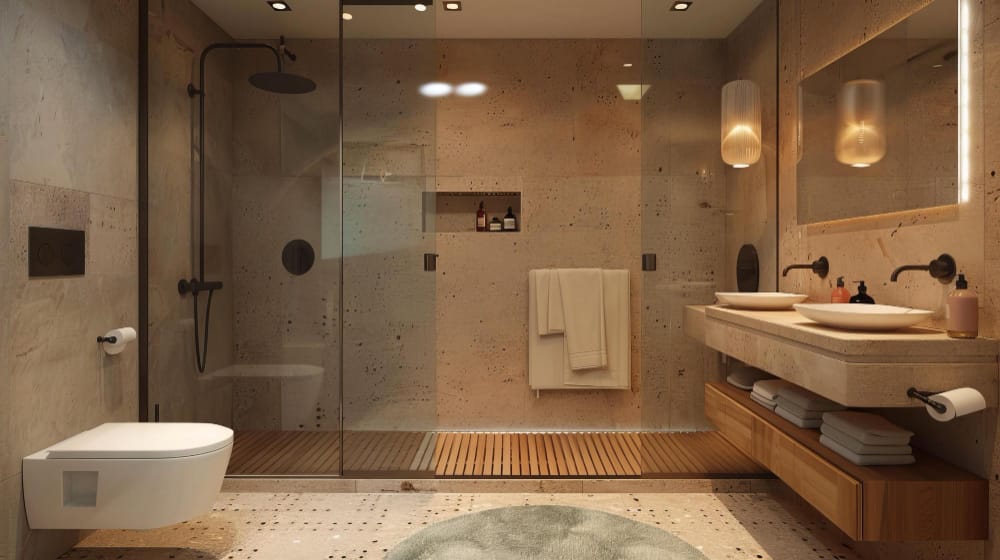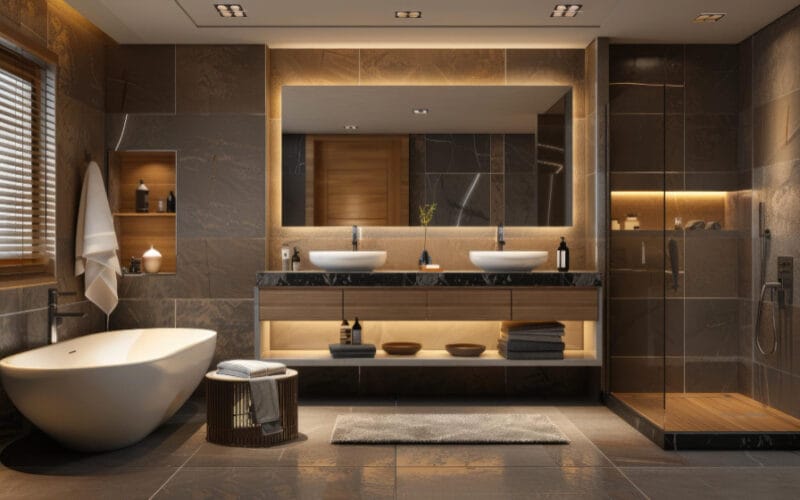Choosing materials for your walk-in shower can feel overwhelming — especially when each option promises style, durability, and easy maintenance. To help simplify the process, this top shower layout inspiration guide breaks down how tile, glass, and stone compare in cost, appearance, and performance so you can make the right decision for your home and budget.
Overview at a Glance
| Material | Average Cost (Installed) | Durability | Maintenance | Design Appeal |
|---|---|---|---|---|
| Ceramic/Porcelain Tile | $8,000–$12,000 | Excellent | Moderate | Wide color & pattern options |
| Glass Panels/Enclosures | $10,000–$14,000 | High | Easy | Sleek, modern aesthetic |
| Natural Stone (Marble, Travertine, Quartzite) | $14,000–$25,000+ | Very High | High | Luxury and timeless texture |
Each material offers unique benefits that influence not only cost but also the mood and longevity of your bathroom design.
Tile: Customizable and Cost-Effective
Tile remains the most popular choice for walk-in showers thanks to its versatility and affordability.
Pros:
Available in countless colors, textures, and shapes
Works for all design styles — modern, rustic, or classic
Easy to repair individual tiles if damaged
Cons:
Requires regular grout cleaning and resealing
Labor-intensive installation can increase costs
Best for: Homeowners seeking creative freedom and long-term durability on a mid-range budget.

Glass: Minimalist and Light-Filled
Glass showers instantly make bathrooms feel larger and brighter — perfect for smaller or enclosed spaces.
Pros:
Expands visual space and enhances light
Pairs beautifully with stone or tile walls
Low maintenance and easy to clean
Cons:
Water spots and soap film can show if not wiped regularly
Custom glass thickness increases cost
Average Cost: $10,000–$14,000 depending on size and hardware.
Best for: Modern, minimalist bathrooms that value openness and simplicity.
Stone: The Ultimate Luxury
If you want your bathroom to feel like a spa, natural stone delivers unmatched elegance and longevity.
Popular Materials:
Marble: Classic veining, sophisticated style
Travertine: Earthy, textured warmth
Quartzite: Durable and stain-resistant
Pros:
Adds luxury and resale value
Every slab is unique
Naturally cool to the touch
Cons:
Higher installation and maintenance costs
Needs sealing to prevent staining
Stone’s tactile and visual richness makes it ideal for premium spaces and long-term investment remodels.
Cost Comparison by Category
| Category | Tile | Glass | Stone |
|---|---|---|---|
| Material Cost | Low–Moderate | Moderate | High |
| Installation Labor | Moderate | Moderate–High | High |
| Maintenance | Moderate | Low | High |
| Lifespan | 20–30 years | 15–25 years | 30+ years |
When factoring in ROI, mid-range tile and glass showers often yield the best balance between value and longevity.
Mixing Materials for a Balanced Look
Many homeowners are now blending materials for visual and functional appeal — tile walls with a glass enclosure, or stone slabs paired with matte fixtures. Partnering with a remodeling expert helps align these design elements seamlessly and cost-effectively.
If your remodel also involves updating plumbing or fixtures, your total bathroom shower upgrade expenses may vary depending on complexity.
Builder’s Notes
The right shower materials define both the aesthetics and usability of your bathroom. Whether you choose budget-friendly tile, sleek glass, or luxurious stone, proper installation and sealing ensure your investment lasts for decades.
👉 Consult a bathroom remodel specialist to explore samples, material combinations, and finishes tailored to your home’s unique layout.
